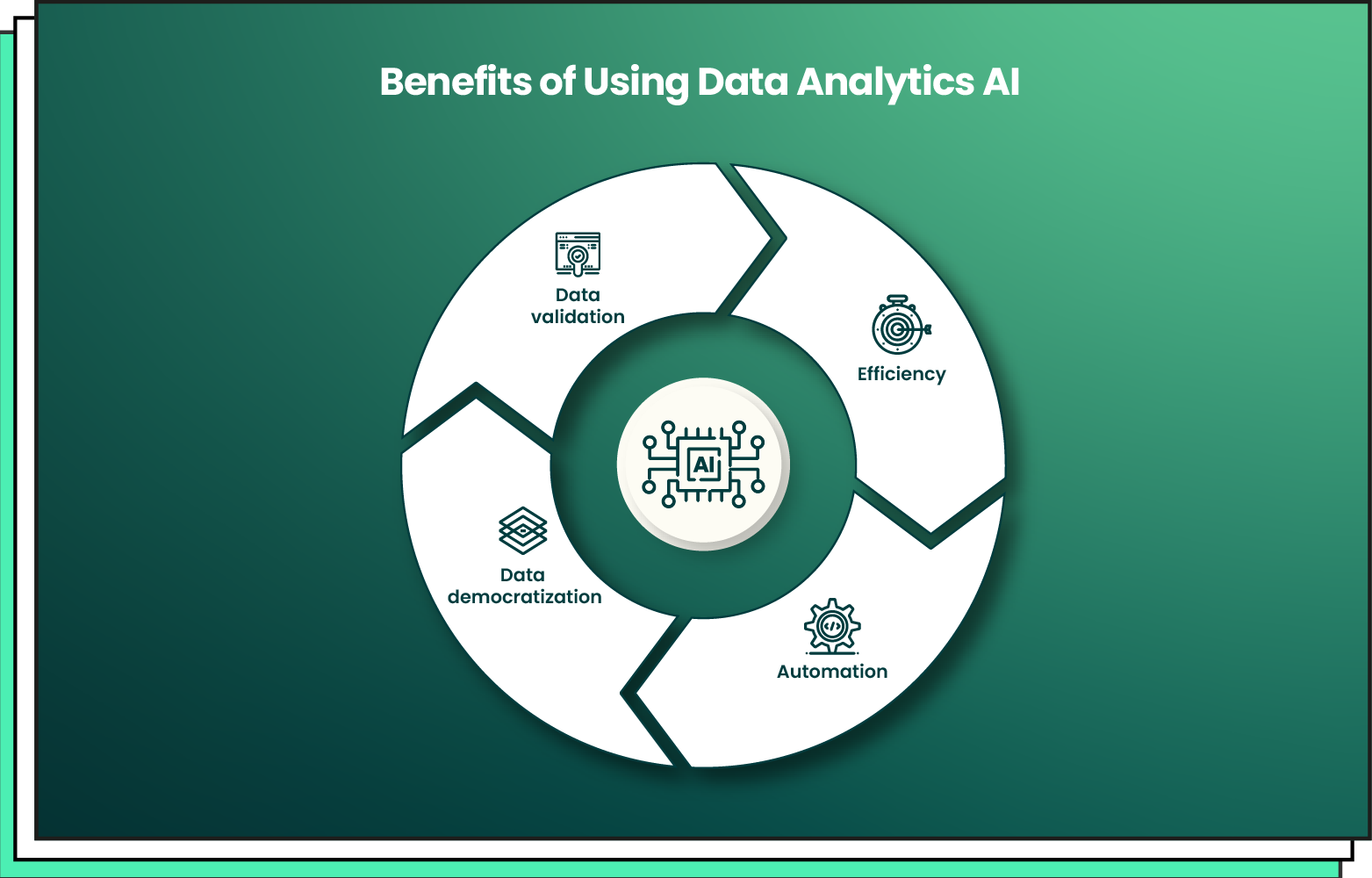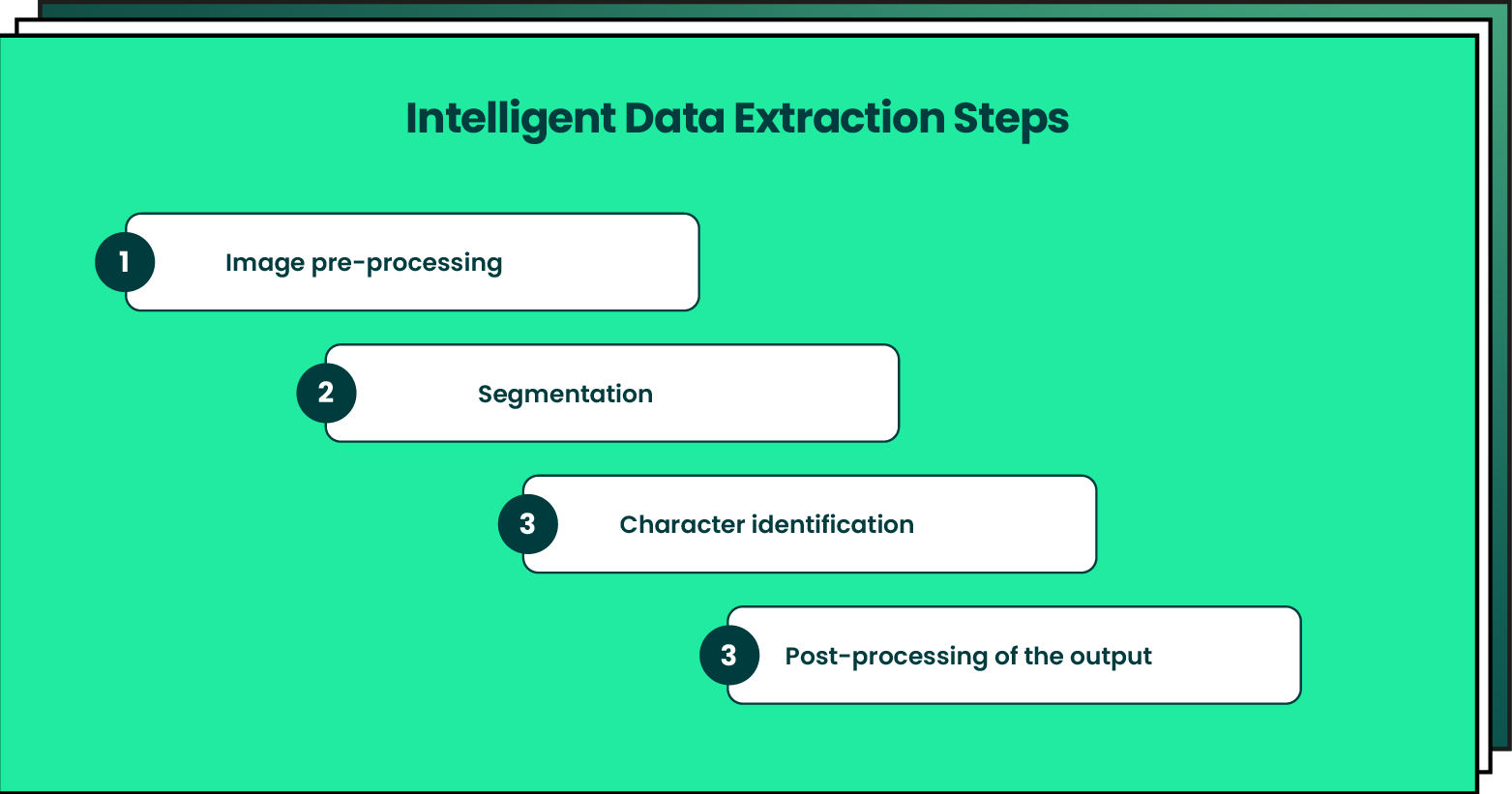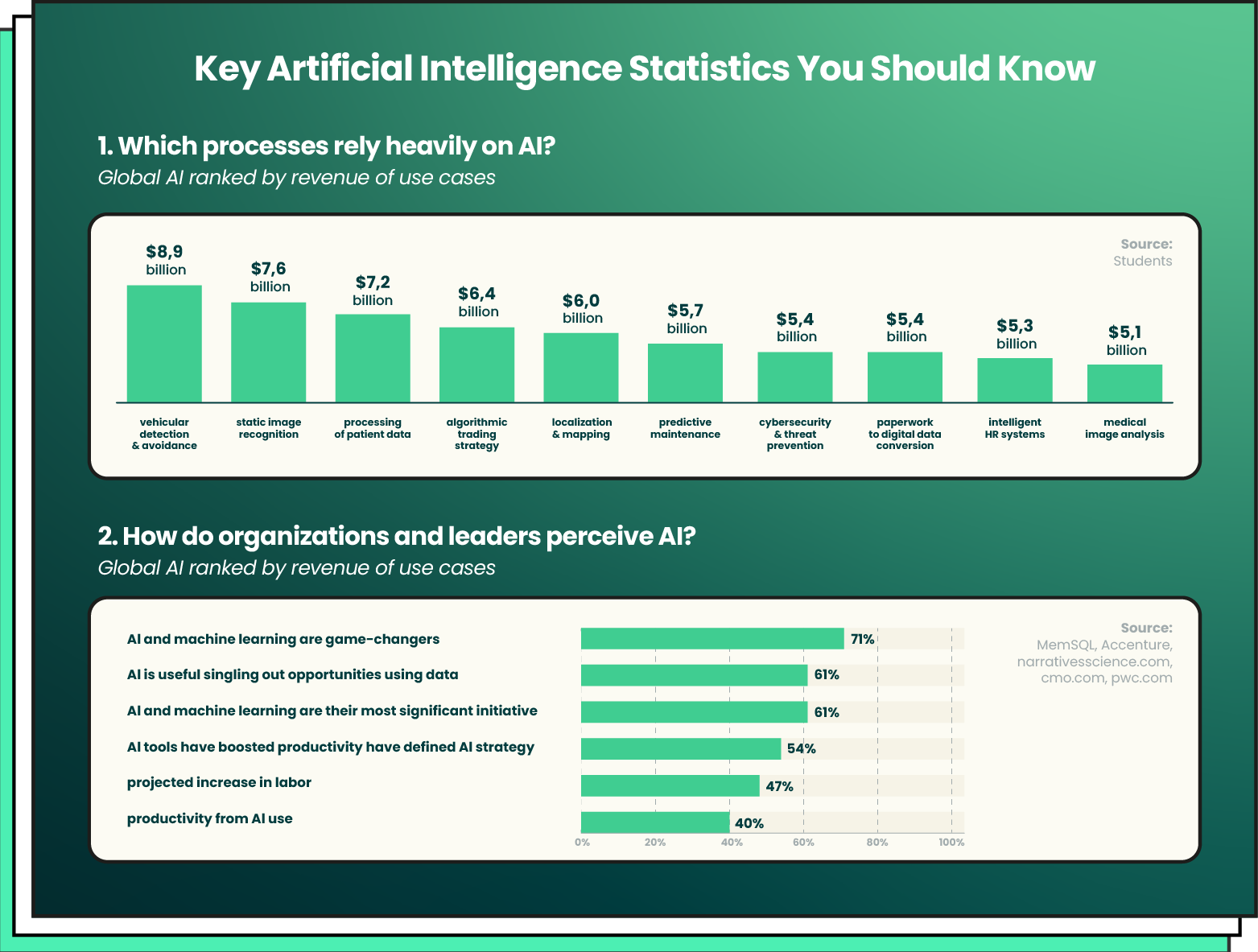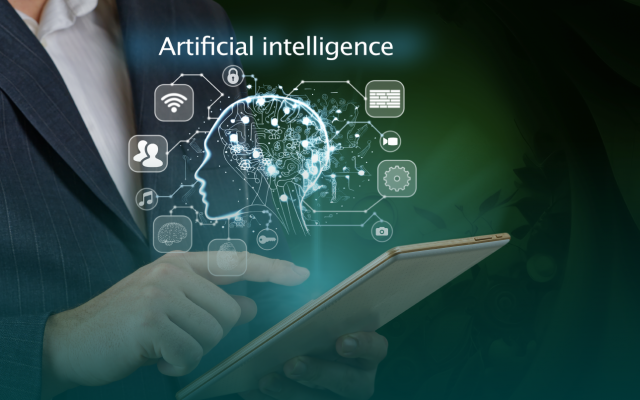AI data analytics improves the accessibility of data. Today, you don’t have to be a data scientist to analyze data and draw insights from it. Anyone, whether a business founder, startup owner, or an ordinary person, can use powerful technology to boost performance, cut costs, and get more control over processes.
What’s more, anyone can facilitate data analytics by delegating this task to artificial intelligence. With AI analytics, insight generation becomes easy, quick, and hassle-free, particularly for those dealing with big volumes of segmented data.
Today, let’s talk about what AI in analytics is, how AI transforms this field, and what steps you should take to implement AI in your data-driven growth strategy.
AI Data Analytics: Meaning and Essence
Data collection is an easy task when you start your business. At this stage, you can analyze and process data manually. But as your company grows, it becomes more challenging to collect and manage data without the involvement of artificial intelligence analytics.
Suppose that you are a big retailer selling goods for international clients. Your supply chain locations include a dozen warehouses that store and manage hundreds of packages. To optimize the supply chain expenses, you need to collect data on warehouse management and analyze the performance of each one separately as well as all warehouses together.
Namely, you may be interested in knowing how long the average order stays in the warehouse, how much space it takes, how many orders stay in the warehouse for longer than 1 week/month/year, etc. To answer these questions, you will have to hire people who will collect data and analyze it. But such an approach increases the risks of errors, data gaps, and calculation mistakes.
Another option is to assign this job to a powerful artificial intelligence data analytics tool that will automatically aggregate data from different sources and analyze it instead of humans. It will also track trends, patterns, irregularities, inconsistencies, and more. All this will help you draw insights into warehouse performance and find new ways to optimize the use of warehouses.
So, AI data analysis refers to various applications of artificial intelligence to process and analyze data, generate insights, and develop data-driven business strategies. According to the FinancesOnline report, almost 60% of organizations that took part in the survey stated AI helped them process big data.
Here are some examples of how AI disrupts the data analytics industry:
- Artificial intelligence lies at the core of the natural language processing (NLP) apps used to process, manipulate, and interpret unstructured data.
- Machine learning algorithms are applied to analyze large datasets, detect patterns in data, and make forecasts based on the learned insights.
- AI is leveraged in deep learning technology that mimics the way the human brain processes data. It’s used for time series analysis, image processing, fraud detection, etc.
Benefits of Using Data Analytics AI
Although the use of AI is not a must in data analytics, more and more vendors are integrating this technology into their SaaS solutions to maximize the benefits their users get. These are the following:

Data validation. With AI, you will effortlessly detect irregularities and inconsistencies in your data. You can use this technology to validate your data and make sure that all your calculations converge.
Efficiency. It takes days, if not weeks, for humans to collect and process data. People’s work and effort should be paid for, which means increased expenses for your business. In contrast, AI can process big volumes of data in minutes and even seconds, leading to more accurate and unbiased results.
Automation. Data analysis AI can automate many tasks and processes in data analytics, including report generation. With artificial intelligence, your employees will automate and customize the reporting processes, ensuring timely access to data for all departments.
Data democratization. The use of AI provides non-technical people with access to insights and data. Data democratization fosters collaboration between teams and departments as anyone can access data analytics results and draw applicable data-driven insights.
6 Applications of AI for Data Analytics
The overall effect of AI’s application in data analytics is the automation of many processes. Among the most widespread applications, we can mention the following:
1. Error and duplicate detection
AI in analytics can be used to analyze big datasets and detect errors inside them. This use case is common when it comes to the visualization of vast data volumes and the development of new machine learning algorithms. Besides, you can apply this smart technology to data cleansing to detect and remove data duplicates. This is an obligatory process to include in data migration projects.
2. Synthetic data creation
One more application of data analytics AI is the creation of synthetic data with smart technology. Usually, AI is used to analyze the data generated by humans. However, the machine is also capable of producing data by itself.
This application is of particular interest to data scientists and machine learning engineers. Synthetic data is data produced by technology. In contrast to this, real data is produced organically as a result of events and processes in the real world. Synthetic data, in turn, is produced artificially and is often applied in training AI models.
Synthetic datasets are easier to create, obtain, and manipulate compared to real datasets. This is why AI engineers often leverage AI to create synthetic data and then feed it to AI models to evaluate their performance.
3. Generating insights and commenting on them
Artificial intelligence data analytics tools can help you generate insights from data analysis and comment on the conclusions. Not only will you get precious business insights but also will be able to understand the reason behind these outcomes. What’s more, you can also ask AI to interpret or explain specific data pieces in datasets to get a deeper understanding of business processes.
4. Extracting data from images
AI’s application in data analytics allows businesses to automatically extract data from images and add it to the corresponding database. For this, the technology of computer vision is applied. This AI use case is common among tech-savvy healthcare providers who leverage smart technology to extract data from MRIs or X-rays. Below, you can see the steps involved in this data extraction process.

5. Reporting
Data analysis AI is also leveraged in preparing the results of data analysis. Namely, it’s used to create reports and visualize data in interactive dashboards. One of our recent articles uncovers the topic of eCommerce dashboards, explaining how to choose the right dashboard and what eCommerce data to display in it. Check it out if you are an ecommerce vendor interested in effective business solutions.
If configured correctly, an AI tool can aggregate data from multiple sources where it is stored and automatically display key insights in the dashboards or charts. The dashboards will contain fresh data updated regularly during the day or week, depending on your preferences.
6. Data search
Manual search can be effective in many cases, but not when you deal with big data volumes. In this case, you will have to go through numerous pages before finding the needed field or entry. AI analytics can save you time and effort and do this job instead of you.
Conversational AI models allow you to ask the technology a question and get a prompt answer. All you need to do is expose your datasets to an AI tool to enable the technology to study data. Then, you will just open the AI interface and type in the questions like:
- On which day in March did we get the highest revenue?
- When exactly did our sales drop?
- What could be the reason for this happening?
Data analytics AI will go through your datasets and find the answers there. For the more complex questions, the technology will look for patterns and correlations between metrics that could be the answer to your prompts.
Forbytes has experience in integrating LLMs like ChatGPT with enterprise systems to automate processes and boost business productivity. Recently, we’ve performed ChatGPT integration with the client’s Product Data Exchange (PDE) platform to automate product description generation and description translation.
With AI, the client saves a lot of time and effortlessly enriches their website with unique and catchy content. Contact us if you are also looking for an experienced AI development and integration company that could help you link your enterprise systems with AI analytics.
Challenges of Using AI in Analytics
Despite the benefits that data analysis AI gives, its application is also associated with some pitfalls. The effects of AI’s use depend not only on the performance of AI itself but also on strategies humans apply. So, these are the top challenges associated with AI in data analysis:
Security and privacy concerns. As you expose your data to AI models, you actually give the technology the right to learn from your data and apply the learned mechanisms to other business cases. This raises a heated debate about data security in AI integration.
Data quality. Before feeding data to an AI model, you should make sure that it’s valid and correct. The outcomes of AI training depend hugely on the quality of data you use. Thus, before exposing your data to an AI data analytics tool, perform data checks, data cleansing, data formatting, etc. to prevent errors and biased outcomes.
The need for AI integration experience. With AI, you don’t have to hire data scientists or tech experts as the technology will perform data analysis instead of humans. However, to start with AI, you still need expert help and AI support services, at least at the early stages of AI adoption.
According to the 2022 McKinsey report, 39% of businesses hired engineers for AI support roles. If you want to save costs in the long run, consider hiring an outsourcing company with experience in AI integration and consulting that will lay the ground for AI’s application to your business.
How Forbytes addresses clients’ issues with AI in analytics
Forbytes is a software development company with a focus on AI integrations and AI in analytics. Most of the projects we’ve completed recently for our clients are either linked to AI or focus entirely on AI integration.
Here’s an example. One of our clients, a big ecommerce enterprise from the Nordics, found it hard to manage data from multiple, disintegrated sources. What’s more, it was also challenging to generate insights as data was stored in several locations with no further implementation. Our team helped the client configure an end-to-end data analytics solution powered by AI.
The tool automatically collects data from multiple sources, centralizes it in one location, and leverages AI to analyze it and generate insights. We’ve also automated report generation for the client, allowing them to customize reports or create brand-new report types anytime.
Contact Forbytes if you need help with data analytics AI configuration and integration. We will plan out the process securely, backing up your data and multiply testing the solution before performing the end-to-end data migration.
The Future of Data Analytics and AI: Evaluating the Prospects
AI will become even more integrated with data analytics. Its role in detecting patterns and trends in data in the shortest time cannot be underestimated. What has usually taken weeks for humans now takes minutes or even seconds for AI to complete.
AI will become an integral part of many data analysis stages, including report generation. As businesses produce tons of data daily, it becomes harder for humans to keep track of it and, more importantly, analyze it. With artificial intelligence analytics, this process can be fully automated. The technology will also be used for drawing insights from data and making data more accessible for non-tech audiences.

On top of that, AI has the potential to strengthen the data security aspect. Its capability to detect irregularities or suspicious patterns in data can help engineers spot unusual behavior and malicious activities in spheres like fintech, ecommerce, real estate, etc.
Thus, positive outcomes of using AI in data analytics prompt us to claim that data analytics and artificial intelligence will grow hand in hand.
How to Get Started with AI-Driven Data Analytics?
If used together, artificial intelligence and data analytics can save a lot of time and effort for businesses striving for efficiency and process optimization. The key insight from this article is that AI technology makes data analytics more accessible for non-tech people and those who’ve never dealt with data analysis. You no longer need to hire specialists in this field as AI will compensate for the gaps in skills or competencies.
But to start benefiting from AI data analytics, you should figure out how to add it to your software solutions. We suggest the following plan:
1. Collect and centralize data. It will be inefficient to integrate AI with each tool you use separately. Insights made by AI at each separate location will be invalid as they will never show you the complete picture of what’s happening in your business. So, before referring to AI, you should centralize your data from multiple sources in one single location.
2. Cleanse the data you collect. This step is essential if you want to train an AI model for correct insights. The cleaner the data, the more correct the results of analysis.
3. Integrate AI into the data analysis process. This can be done by selecting and integrating the right artificial intelligence data analytics solution. Forbytes regularly performs AI integrations and can help you fully automate the data analysis process with AI.
4. Visualize data. Visualization helps humans easily perceive and process data. You can configure automated reporting and data visualization in a convenient format. For this, pick a reliable business intelligence tool where you will create and customize data dashboards and interactive charts displaying key performance metrics and outcomes.
5. Generate and implement insights. Feed historical data to an AI data analysis tool to enable the latter to detect patterns and trends and make forecasts. The insights you get can be used to optimize your processes, test various user engagement strategies, manage risks, and more. Data-driven decision-making in business helps companies prepare themselves for the changing consumer demands and stay competitive in the dynamic market.
You can use this brief plan as a checklist when preparing your data for AI analytics. Contact Forbytes if you need help with any of these steps. With more than 13 years of experience, we know how to make the process of AI integration hassle- and risk-free.









